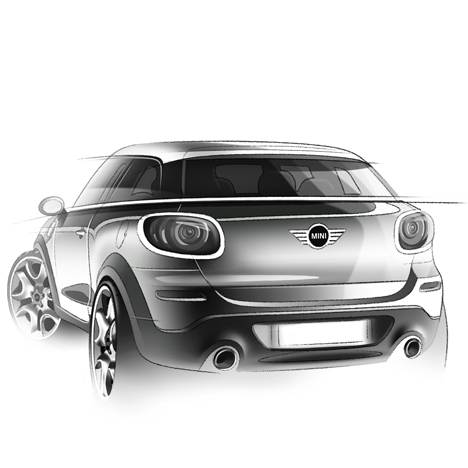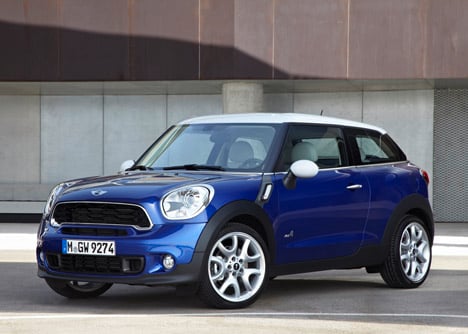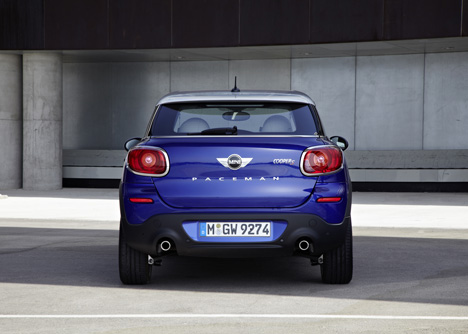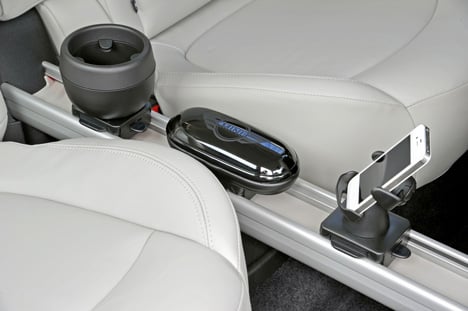
"We're not too far away from driverless cars" - MINI head of design Anders Warming
MINI's head of design Anders Warming predicts that "we're not too far away" from driverless cars in this interview with Dezeen, recorded at the launch of the new MINI Paceman in Mallorca (+ audio + transcript).
Above: listen to the interview with Anders Warming
"It's very clear that self-driving cars are part of the future that we'll be living in, in one shape or form," says Warming. However, he is not convinced that driverless cars will appeal to everyone. "I can understand the need for something like a self-driving car, on the other hand I like to be able to drive my own car, decide how I want the car to handle around a corner. I like to drive cars, so that's a hobby of mine that isn't going to go away either," he explains."I think a lot of people feel like that as well."
Other advances he mentions include the increasing the amount of interactive technologies drivers will have access to in their vehicles, and the integration of social media into new models. "It is very important for us is to expand on the world of user interface, that interactivity that people are used to in their everyday lives."
"What you can do with a phone these days means that a very important area of innovation will be in the adaption of this user interface world within the car realm. With the edition of what we call MINI Connected, it's the first time anyone has launched the concept that you have Facebook directly in your car and you have this connectivity in a level not known before," he continues.
When asked about what the BMW group are doing to reduce the amount of cars on our roads, Warming describes a car-sharing project that has already in place in Munich and Berlin and is due to launch in other cities. "Drive Now is a program that allows someone who might not own a car to get in BMW product within five minutes. This car sharing thing I think is a sign of the time. Is car driving and the fun of car driving equal to owning a car? I think that is going to change, just like people over many decades having to deal with leasing rates as opposed to owning a complete car."
Anders Warming has been the head of design at MINI since 2010 and has worked as a designer for the brand for 16 years.

The interview took place at the launch of the Paceman (above), MINI's latest model that is a cross between a sports activity vehicle and a coupé - see our story about it here.
See all our stories about MINI »
See all our stories about cars »
Read the transcript of the full interview below:
Anders Warming: My name is Anders Warming and I'm Danish, but I've been working with the BMW group for a good part of 16, 17 years as a car designer. I'm a car designer by education and that obviously means that I've been located in Germany or America for many, many years designing cars. For a couple of years I've been responsible for the MINI design team, meaning I'm responsible for every car that MINI has designed that is coming out: the interior, exterior and the whole colour and material programme.
Dan Howarth: Could you explain the way you go about designing a car?
Anders Warming: Well there's two answers to the question. On the one hand, there is the process of how you go about things and the other thing that is important for me of course is the brand that you are designing and working with. Starting with the process, you usually have to take into account the car that has the most fans and the most customers out there, and in order to do that we do ask customers, we do gets some feedback as far as who would be interested in a certain kind of a car, and based on that we'll start the design process and a design project. Once we know the size and dimensions of a car, we'll go into a design competition where we'll have different proposals for the interior, exterior, and for the colour and material, and through a bandwidth of options we'll select down to the one car we then prefer. That process usually takes from three and four years altogether, sometimes more. Particularly the Paceman was a very short process, so it took us just under three years to start from the first idea to test the car into production.
The other side of car design is obviously pertaining to MINI as a brand, and MINI is for me personally a very important brand because it's a car that started from a very highly engineered level. Obviously the MINI classic was designed in the fifties and had such an impact on the world of mobility. A small, clever package that everyone liked, that's why it sold millions and millions in the fifties, sixties and seventies, and also the eighties and nineties as well. When we reintroduced the brand we found that the hatch is a strong product, people really need a little hatch and for MINI this is very important for its history but also for right now. When the car was introduced it was important within the context and today, eleven, twelve years after the brand was relaunched, we are finding that brand is becoming more and more important to people. Why? Because it's a car with so much character and so much emotion that you identify with when you see it, and you like the car on a couple of emotional levels. The car rides like a go-kart and it looks, I would say, beautiful. It's a great looking car and it's got superior quality. This is something I think is part of what we have to think about when designing every MINI. But designing every MINI we have to take two things into account. One is the heritage I mentioned, where we come from, and the other thing is always to be on the cutting edge of new innovation. So the balance between maintaining what is successful is a part of our design process, always to look at where we come from, and the other side of that obviously is to say where do we innovate and where do we go new ways.

Dan Howarth: And what sort of innovative features does the Paceman have specifically?
Anders Warming: Several, on a couple of different levels. One, for example, is the overall concept. It's an innovative concept, it's a car that the world has never seen before in that shape and form. The concept it called the Paceman obviously, but the concept is a so-called SAV or an SAV coupe, meaning it's a sports activity vehicle with a coupe roofline. This is a vehicle that has never been launched in that unique format. There has been three-door and five-door versions of these kinds of cars, but never a specific three-door coupe on a sports activity vehicle. That's one strong innovation, the concept in itself, it's a car that's new that will find fans, but in that sense it has never been done before. What we really focused on is to create a design of a car that takes MINI into a next innovative look, especially in the rear where you see for the first time, in the Paceman, the horizontal tail lights. Where MINI so far had the vertical lights sitting on the out board of the fenders, we have now horizontal emphasis at the back that gives an impression of width. That's completely new to MINI. So far MINIs were more narrow and tall from the dynamic look but now we're actually talking about the impression of width and have made the shoulders even wider on this car. Third thing I want to mention is the interior concept, that it's a coupe with superior rear head room. And that for me is an innovation that we are able to get something that emotional, that sporty, you are actually able to sit in the back very comfortably and you have two individual chairs that give you that feel of sitting in a lounge.
Dan Howarth: Going back to the width, is there a reason you decided to emphasise that particularly on this model?
Anders Warming: Well the impression of width I think is the expression of the dynamism, it makes the car look dynamic on the road and it's something that has been learned throughout generations, also with other car brands. I think it fits the dynamic of the car MINI, the way it handles. I believe it drives very well and it's very precise and go-kart-like, so I think horizontal tail lights emphasise this road holding. The other reason is that the car has a very specific technical basis out of the Countryman, and with the horizontal lights on the Paceman we are differentiating the rear view from the Countryman which looks taller and has more vertical emphasis with the vertical lights, and the Paceman has the horizontal. So in that sense we keep these two concepts looking more unique in the rear view.
Dan Howarth: Is it more energy efficient than other MINIs?
Anders Warming: Let's say the engine work we've been doing in the BMW group overall is part of what we call the efficient dynamic program, which means that everything is measured, every gramme is being looked at, little improvements to the engine performance are being looked at, improvements in aerodynamics is being looked at. These cars, and any car from the BMW group, is right now on the highest level you can get as far as the convergence of aerodynamics, lightweight and energy efficiency. So efficient dynamics is sort of the thing in the foreground. We at MINI call it minimalism but in essence it's got the same meaning as far as fuel saving and the whole balance of the ecosystem. This car is a larger MINI based on the Countryman, so it's larger than the hatch and therefore has a little bit more weight to the concept itself, but what we're really happy with this car is that it still is, in a MINI-typical way, the smallest car in its segment. That means that any car that would be a competitor to this car would be larger and heavier than this one.
Dan Howarth: Looking forward, are there technologies that you are already thinking about integrating into new models?
Anders Warming: The world is a extremely fast-paced and changing, we have so many things that are happening all over. Like I mentioned the words efficient dynamics or minimalism in the case of MINI, the technologies that we apply are all geared towards lowering the weight, lowering emissions, and making sure that the car is even more fun to drive within those parameters. Obviously I hope the cars will be even more beautiful for every generation, this is our goal, but I think as far as technology goes this is going to be a prime focus. The other thing that is very important for us is to expand on the world of user interface, that interactivity that people are used to in their everyday lives, especially due to computers and phones, and what you can do with a phone these days means that a very important area of innovation will be in the adaption of this user interface world within the car realm. Right now I believe that MINI has got a great level as far as navigation system works for example, because with the edition of what we call MINI Connected, it's the first time where anyone has launched this in a car where you have Facebook directly on your car and you have this connectivity in a level that is not known before. Right now we are seeing a lot of other people doing it as well because it is logical and it's the logical thing to do, but these are two areas of innovation: focus on the minimalism and efficiency and focus on the adaption of user interface and connectivity.

Dan Howarth: So integrating things like social media, and other technologies, touch screens - I know that's not particularly new - but is that developing quite quickly?
Anders Warming: It's developing quite quickly but my feeling is that there are so many things developing that quickly that it you listen to everything all at once you might get the impression that certain things are set in stone. I don't believe they are set in stone, I believe there is so much due to the fact that the development processes are being sped up all over the world, there will be technology that will develop very quickly that no one will foresee. Maybe a mix of different kinds of user interface concepts, whether it's through our iDrive controller, or the MINI controller or touch-screen technology or header displays. At the end of the day, the customer would like the choice of different technologies, just like the customer would like the choice of colours, whether they want a black or blue or yellow car.
Dan Howarth: So customisation is going to be key in the future?
Anders Warming: Customisation and adaptability of technology within product life cycles.
Dan Howarth: And even further ahead, there are ideas being thrown about a lot at the moment about driverless cars. How far away do you think we are from that?
Anders Warming: I think that we're not too far away from these technologies, I do know that most major brands are developing programmes for these issues. There are also non-automotive brands that are also doing this, so it's a very clear thing that self-driving cars are part of the future that we'll be living in, in one shape or form. When and how and in what context, obviously as a mere designer, I'm not to say. But I do know there is a huge drive for innovative ideas. On the one hand, that is something that is just washing in, these new ideas. On the other hand I think the customer is always going to went to have a great slash beautiful car to drive everyday. So I wouldn't take away too much from the customer that actually likes to interact with this car. So also I think it's a case of adaptability. I'm a car enthusiast and I can understand the need for something like a self-driving car, on the other hand I like to be able to drive my own car, decide how I want the car to handle around a corner. I like to drive cars, so that's a hobby of mine that isn't going to go away either. I think a lot of people feel like that as well.
Dan Howarth: A lot of governments and city councils are trying to cut down on the amount of cars on the roads. Are you developing any alternatives?
Anders Warming: Definitely, the BMW group has been very active in a pilot project called Drive Now that is working in Munich and Berlin and will be launched in other cities. Drive Now is a program that allows someone who might not own a car to get in BMW product within five minutes. This car sharing thing I think is a sign of the time. Is car driving and the fun of car driving equal to owning a car? I think that is going to change, just like people over many decades having to deal with leasing rates as opposed to owning a complete car. It's about mobility concepts for the future, and BMW group, not only MINI but other BMW products are right now all being aligned and function in the market as mobility packages that really will help people find their way of getting into the brand. Not my way of getting into it, but if they want to purchase it they can, if they want to lease it they can, if they want to take part in car sharing they can, but whatever way they can get access to a MINI.